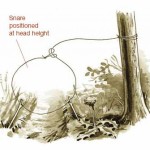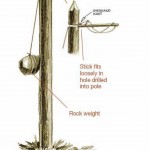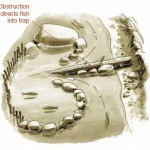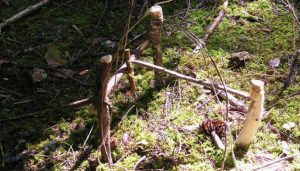 If you do find yourself in the wilderness and need food, there are a lot of ways to fill the plate for dinner. Now, I will be the first to say that using primitive methods like this are not the easiest thing in the world. People who rely solely on trapping food routinely have multiple traps, they aren’t the heaviest people in the world generally and often can go without food for a few days if they are unlucky to find anything in their traps.
If you do find yourself in the wilderness and need food, there are a lot of ways to fill the plate for dinner. Now, I will be the first to say that using primitive methods like this are not the easiest thing in the world. People who rely solely on trapping food routinely have multiple traps, they aren’t the heaviest people in the world generally and often can go without food for a few days if they are unlucky to find anything in their traps.
Actually, if you plan to Bug Out into the closest national forest with nothing more than your Bug Out Bag, your family and your trusty .22 rifle, I would not count on using these methods below as your sole source of food for a wide variety of reasons. To tell the truth, I wouldn’t recommend doing that (Bugging Out) for any real reason unless you have zero other options.
That being said, the methods below do work and have worked for a very long time. If you have the time, patience and are lucky enough to have an animal wander through your path, the traps below can be used to catch game and it is wise to have knowledge like this in your back pocket just in case.
Snares
Small-game snares can be made from the interior strands of parachute cord, braided strands of sinew, or fishing line. Snares stout enough to secure game as large as deer need to be made of rawhide or parachute cord.
Ground Snare
1. Ground Snare
Position the snare at head height and tie off the end to a tree, a stake in the ground, or a log that the animal can only drag a short distance as the noose tightens. Make snares from cord, fishing line, or wire if available. Very thin wire is probably the best for this type of snare I think because when tightened the wire doesn’t easily work itself loose. Paracord internal strands are much smoother and can slide off more easily.
A good place to position this snare (and a lot of them actually) is on a game trail. You have probably walked over hundreds of them if you have spent any time at all in the woods. The trick is to watch the ground floor and you can see trails. Set this snare up in a curve on the trail and cover the snare as much as possible with leaves to camouflage it.
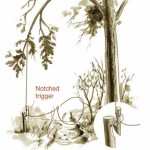 2. Spring Snare This snare functions by setting a trigger that snatches game into the air as it strains against the noose. It’s good for rabbits and game as large as deer. There are two main gotchas to remember with this trap. The first is that you want to choose a tree that will be both springy enough that it will spring back quickly enough to set the snare. This may be hard to do because the location of the snare will need to depend on what tree branches or trees are near.
2. Spring Snare This snare functions by setting a trigger that snatches game into the air as it strains against the noose. It’s good for rabbits and game as large as deer. There are two main gotchas to remember with this trap. The first is that you want to choose a tree that will be both springy enough that it will spring back quickly enough to set the snare. This may be hard to do because the location of the snare will need to depend on what tree branches or trees are near.Deadfall Traps
Deadfalls that use logs or rocks to squash prey are typically baited, but they also work along trails or outside burrows when a passing animal or bird brushes against the trigger.
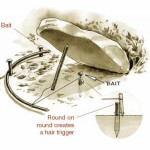 3. Spring Deadfall One of the easiest traps to make and set, the spring deadfall depends upon the game going after the bait, so it’s best used for carnivorous animals and rodents such as pack rats. The only materials you need for this trap are a big heavy rock or a big log. Something big enough to crush the skull of the animal you are trying to trap. This has to be big enough to kill them pretty quickly.
3. Spring Deadfall One of the easiest traps to make and set, the spring deadfall depends upon the game going after the bait, so it’s best used for carnivorous animals and rodents such as pack rats. The only materials you need for this trap are a big heavy rock or a big log. Something big enough to crush the skull of the animal you are trying to trap. This has to be big enough to kill them pretty quickly.Tension Traps
Employing fire-hardened spear points under tension, these can be deadly to predator and prey alike. Always set and approach an impaling trap cautiously from behind and use only in an emergency in remote areas, where another human or domestic animals are not going to blunder past.
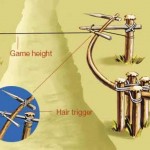 4. Spring Spear Trap This trip-wire set is effective for wild pigs, deer, or other game that regularly sticks to defined game trails. Make certain the horizontal thrust of the spear is at a level that will impale the body of the game sought. This is an extremely dangerous trap; use it with caution.
4. Spring Spear Trap This trip-wire set is effective for wild pigs, deer, or other game that regularly sticks to defined game trails. Make certain the horizontal thrust of the spear is at a level that will impale the body of the game sought. This is an extremely dangerous trap; use it with caution.Bird Traps
Birds can be much easier to trap than mammals and should be among your first targets for a meal.
Ojibwa Bird Pole
5. Ojibwa Bird Pole Set this trap in a large clearing where birds will naturally seek it out as a landing place.
- Step One Sharpen both ends of a 6-foot pole and drill a small hole near one end. Drive the other end into the ground until it is secure.
- Step Two Cut a 6-inch-long stick that will loosely fit into the hole. Tie a rock to a thin cord and pass the cord through the hole in the pole, then make a slip noose that drapes over the perch.
- Step Three Tie an overhand knot in the cord in back of the slip noose and place the stick against the hole. Tension should hold it in position. When a bird flies down and perches, it will displace the stick, the rock will fall, and its feet will be caught as the loop quickly slides through the hole.
Fish Traps
Fish swim next to banks at night or move from deep holes into shallow water to feed. They can often be directed into traps from which they are unlikely to escape.
Funnel Trap
6. Funnel Trap Make the walls of the funnel trap with piled-up stones or tightly spaced sticks driven solidly into the river or lakebed. Close the entrance to the trap, roil the water, then either spear the fish or net them with a seine made by tying a shirt or other cloth between two stout poles.
This is one of the easiest traps to be successful with I think. I haven’t ever used it, but the logic seems to give you a much better chance of success provided you are near a water source and there are fish in there obviously. This is also one method used in the book “The Hatchet” which my kids really like. I think I liked it more than them, but regardless if fish are near, this is far easier than fishing. Seed the trap with whatever you can find for bait and the fish should file in for you. This is also great because if you are in the woods for a long time, a trap like this can keep bringing you fish and keep them alive until you are ready to eat them.

